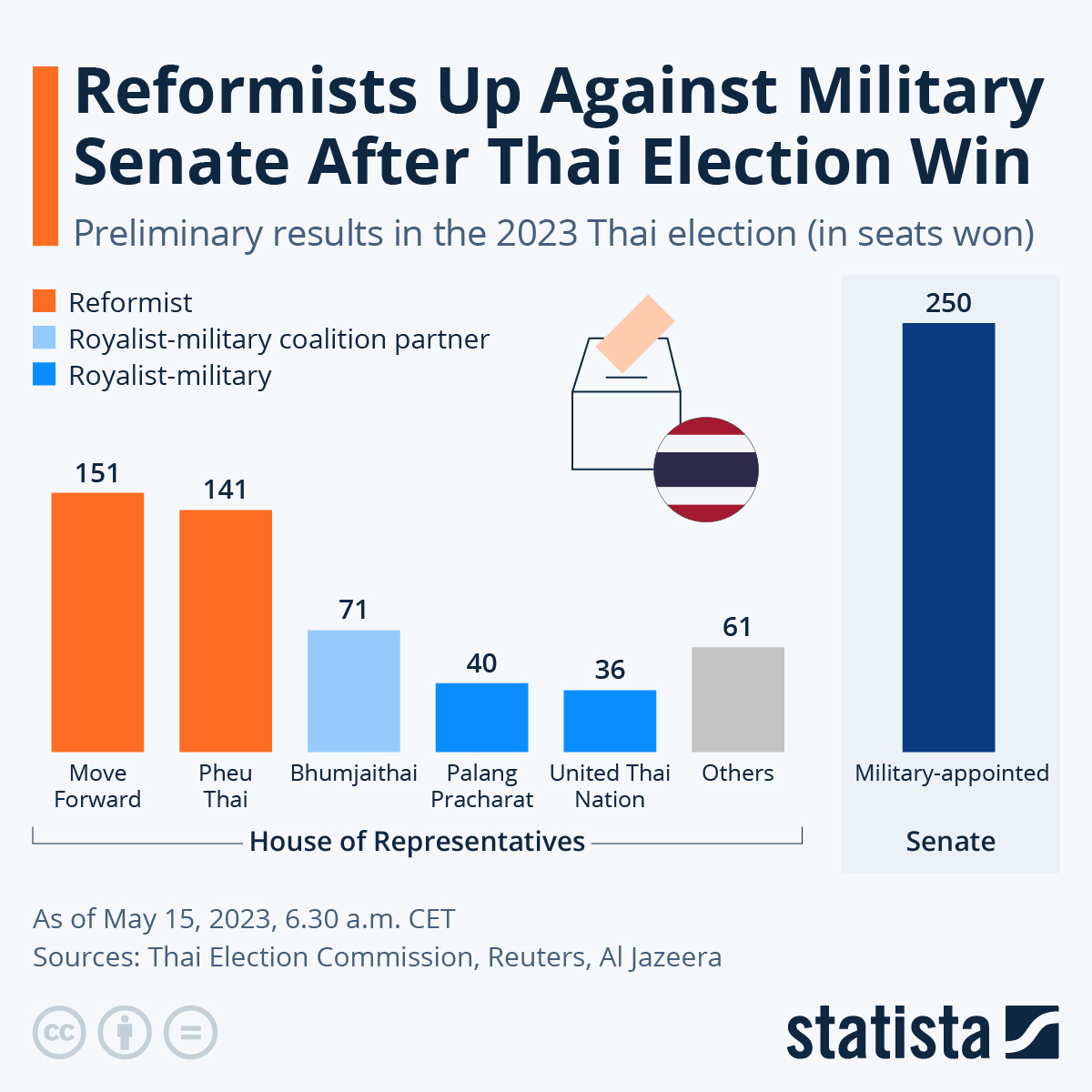Balancing Democracy and the Old Order: Thailand's 2024 Senate Elections
Analytics of Strategic Voting in in a Potential Condorcet Outcome (that's a good thing)
Thailand's Parliament building in Bangkok.
Photographer: Valeria Mongelli/Bloomberg
A friend from Bangkok is interested in the ongoing Thai Senate elections, which started on June 9, 2024, and will continue until June 26, 2024. The results will be announced on July 2, 2024. The voting has been described as “the most complicated election” in the known world, as detailed in Emma Kenny's explainer for IDEA. In this election, voters are required to cast three ballots at the district, provincial, and national levels, and it is compulsory. My friend needs advice to pass on to the candidates.
My interest in the Senate election was sparked by an interview with the two filmmakers behind "Breaking the Cycle," a documentary about the 2019 election in Thailand and the unsuccessful candidacy of Thanathorn and the Future Forward party. The somber roll call of senators, a procession of elderly men depicted in the film, was particularly memorable. The repeat performance in 2023 with Pita and the Move Forward party rankled bitterly. The 2024 Senate election through the lens of modern political science, focusing on the overall impact of the design. This is essential because many suspect the system will create incentives for complex election strategies that benefit insiders, particularly the military and royal establishment. Ihe framework comes from a recent Harvard working paper, "Election Methods and Strategic Voting" by E. Maskin and R. Robinette.
The rules for the 2024 Senate elections were established in the 2017 Constitution, which was drafted under military rule. There are seventy-seven constituencies based on Thailand's 77 provinces, with each province electing between one and three senators depending on its population. Candidates must be at least 40 years old, hold a bachelor's degree or equivalent, and not be members of or affiliated with political parties, and there was uncertainty regarding their ability to campaign in the media. Voting is compulsory for Thai citizens aged eighteen and older. The candidate with the most votes in each constituency (collected across all three levels) wins the Senate seat. In addition to the 77 elected senators, 73 senators will still be appointed, chosen by a committee of state employees: judges and officials.
The partially appointed nature of the Senate is controversial, as it means a sizable portion of the upper house will not be democratically elected by voters. However, the percentage of appointed senators has decreased from 100 percent in the previous Senate to approximately 30 percent.
Recalling the Book of Matthew about motes and beams in one's eyes, the Canadian Senate is appointed by a single individual, the Prime Minister of Canada. Only Alberta challenged the existing system by holding non-binding provincial elections for Senate seats. Notably, Stan Waters, elected in 1989, was appointed graciously by Prime Minister Brian Mulroney. The full process is on hold.
The Thai Senate elections have significant implications for public policy, given the Senate's substantial powers. The Senate acts as a check on the popularly elected House of Representatives and plays a role in selecting the Prime Minister. For the first time in a decade, the Thai people will elect most senators.The Senate might evolve to be more responsive to the will of the voters and break the deadlock between the military and democratic supporters. The July outcome could represent a change towards fuller democracy. Opposition parties should keep in mind that winning elections may require flexibility to address voters' top concerns to maintain a functional political system.
Thailand's Senate elections, while a step forward, show there is still work to be done reforming the body. The complexity of the voting system creates opportunities for insider manipulation. Continued efforts are needed to simplify the process and move closer to the democratic ideal of a fully elected, strategy-resistant Senate.
Maskin and Robinette provide useful insights that we can apply to analyze the Thai Senate elections. An important piece of information to consider: a First Past the Post “plurality” system rewards the candidate with the most votes even if it is not a majority. A Condorcet system uses ranked ballots, 1st, 2nd, and 3rd choice, and then tallies a total – a third-place ballot being worth one-third of a first-place ballot. Here are the key points:
1. Single-peakedness of preferences: Maskin and Robinette argue that in many political elections, voters' preferences are single-peaked along a left-right ideological spectrum. If this holds for the Thai Senate elections, it will imply that a centrist candidate could be a Condorcet winner (preferred by a majority to any other candidate).2. Strategic Voting: The article highlights how various voting methods, including ranked-choice voting (where the Thai voter could vote for three candidates with three ballots), are vulnerable to strategic voting, where voters misreport their true preferences to achieve a preferred outcome. In the Thai context, there may be incentives for strategic voting, particularly given the role of the military-appointed senators and the high stakes around the Senate's powers.
3. Importance of Voting Method: The Thai Senate elections use a plurality voting method in each province, which is more vulnerable to vote-splitting and strategic voting than a ranked-choice or Condorcet method would be. By having three ballots, a Condorcet winner is possible.
4. Neutrality and Fairness: The article emphasizes the importance of neutrality in treating candidates equally. In the Thai context, there are concerns about the fairness of the Senate elections, given the exclusion of partisan candidates and the presence of appointed senators.
5. Implications of Senate Composition: Maskin and Robinette's article focuses on voting methods to determine a single winner. However, in the Thai Senate elections, the overall composition of the Senate matters due to its significant powers. The mix of elected and appointed senators, and the distribution of party affiliations and ideologies, will shape the Senate's behavior as an institution.
In summary, although the specific voting method proposed in the article may not directly apply to the Thai Senate elections, the broader insights about single-peakedness, strategic voting, neutrality, and the importance of the voting method are relevant for analyzing the Thai context.
What advice do Maskin and Robinette offer to Thai Senate candidates to counter the probable strategies held by insiders who had a hand in developing the voting system?
Strategies for Thai Senate Candidates:1. Position as a centrist to build a broad coalition as a Condorcet winner.
2. Encourage sincere voting to increase likelihood of a Condorcet winner.
3. Highlight diverse support to be resilient to strategic voting.
4. Advocate for voting reform towards more strategy-resistant methods.
5. Build cross-ideological alliances to increase Senate influence.
6. Focus on local issues to build a strong provincial base.
7. Emphasize independence to stand out amidst military influence concerns.
Specific strategies will depend on the candidate's context, background, and the evolving political landscape. Emphasizing sincere voting, diverse support, and strategy-resistant methods could improve their chances.
As senate reform takes hold in Thailand, the parties should send a delegation to Canada. The Canadian political parties and its august Senate could benefit from the lessons learned in Thailand's journey towards a more democratic and representative upper house. Canada on the whole may learn a thing or two.





